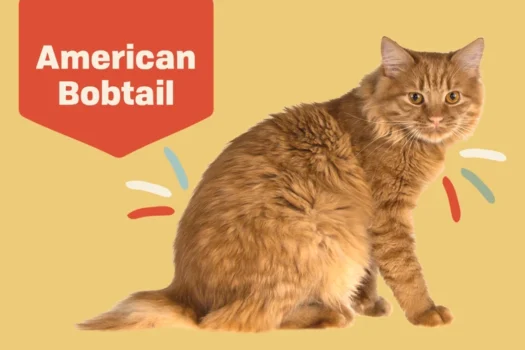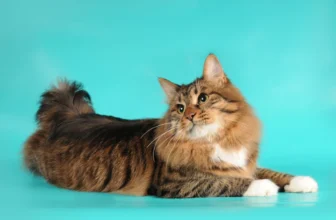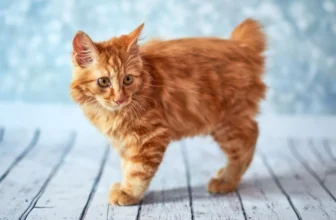It’s no secret that American Bobtail cats are fascinating creatures, captivating the hearts of many feline enthusiasts. As a cat owner, deciphering the body language of these furry friends is key to developing a deep bond with them. However, it can be a perplexing task to understand the subtle nuances of their gestures and movements. Are they playful or aggressive? Do their ear movements signify contentment or annoyance? In this comprehensive guide, we’ll explore the body language of American Bobtail cats in detail, giving you the tools you need to interpret your cat’s mood and behavior. From tail positions to vocalizations, we’ll cover it all. So grab your cat, sit back, and let’s dive in!
General Body Language
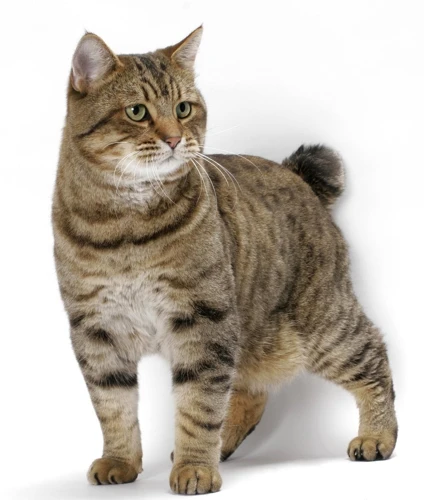
As pet owners, understanding our furry friend’s body language is essential to maintain a healthy and happy relationship with them. This is particularly true for American Bobtail cats, who have a unique set of traits that set them apart from other feline breeds. Learning to read their body language can provide insight into their emotions and behaviors, ultimately leading to better care and communication. So, what are some common cues to look for in American Bobtail cats? Let’s dive into their general body language.
Tail Position
Understanding the Body Language of American Bobtail Cats involves paying close attention to their tail positions. A cat’s tail can tell a lot about how they are feeling. Here are some common tail positions and what they may indicate:
| Tail Position | Meaning |
|---|---|
| Straight up | This typically indicates a happy and confident cat. If the tail fluffs out at the end, it may mean that the cat is feeling particularly excited and playful. |
| Slightly twitching | When a cat’s tail is twitching slightly, it may mean that they are feeling mildly irritated or curious about something. |
| Puffed up | A puffed-up tail is usually a sign that a cat is feeling scared or threatened. This is a common defensive posture that cats take when they feel threatened. |
| Tucked between legs | When a cat tucks their tail between their legs, it usually means that they are feeling afraid or submissive. |
| Wagging rapidly | Just like dogs, when cats wag their tails rapidly, it usually means that they are feeling agitated or angry. This is often accompanied by other signs of aggressive body language like dilated pupils and flattened ears. |
| Curled around another cat or human | When a cat curls their tail around another cat or human, it is usually a sign of affection and trust. This is a common gesture of bonding and social interaction. |
By paying attention to the position of an American Bobtail’s tail, you can get a better idea of how they are feeling and what their mood may be. Tail position is one aspect of a cat’s body language that is easy to observe and understand.
If you’re interested in learning more about clicker training for American Bobtails or understanding common behavior problems in this breed, check out our other articles on /clicker-training-american-bobtails-start/ and /common-behavior-problems-american-bobtails/.
Ear Movement
A cat’s ear movements are a good indicator of their mood and level of concentration. American Bobtail cats have expressive ears, and knowing how to read their ear movements can help you understand your pet’s body language. Here are some common ear movements that your American Bobtail might engage in:
| Ears Forward | If your cat’s ears are pointed forward, they are alert and interested. This is a common ear movement when your American Bobtail is playing or being petted. They might also make some noises to show their joy. |
|---|---|
| Flat Ears | If your cat’s ears are flat against their head, they are feeling anxious. This can happen when your pet is in danger or when they are in a new environment. It is also a common ear movement when your cat is upset, annoyed or threatened by something. |
| One Ear Up, One Ear Down | If one ear is up and the other ear is down, it usually means that your American Bobtail is in a relaxed state. They may do this while lying on their back, but beware, as they can quickly become alert if you approach them or touch them in any way. |
It is important to follow your pet’s ear movements to know when they are feeling happy or when they are in distress. Knowing when your American Bobtail is uncomfortable or scared can help you avoid unpleasant situations. If your cat looks anxious, try to investigate what’s causing their discomfort, and help them to feel safe and secure.
Consider reading: If you haven’t trained your American Bobtail yet, you might be interested to learn about the benefits of reward training. Click here to learn more.
Purring and Meowing
When it comes to communicating with their human companions, American Bobtail cats often use a combination of purring and meowing. While purring is typically associated with contentment and relaxation, it can also indicate pain or illness. Similarly, a meow can communicate a variety of messages, such as hunger, excitement, or distress.
Table: Meaning of Purrs and Meows in American Bobtail Cats
| Purrs | Meaning |
|---|---|
| Low and Breathless | Physical discomfort or pain |
| Continuous and Steady | Contentment and relaxation |
| Loud and Intermittent | Excitement or seeking attention |
| Meows | Meaning |
|---|---|
| Short and High-Pitched | Greeting or acknowledgement |
| Long and Drawn-Out | Hunger or impatience |
| Loud and Insistent | Distress or urgent needs |
It’s important to pay attention to the specific tone, volume, and duration of your American Bobtail’s purrs and meows in order to understand their intended message. Additionally, observing their body language, such as the position of their ears and tail, can also provide important context for their vocalizations.
If you’re interested in learning more about training your American Bobtail cat, check out our article on basic commands for American Bobtail cats. If you’re considering adopting an American Bobtail kitten, our article on socializing American Bobtail kittens can help you prepare for their arrival.
Specific Body Language
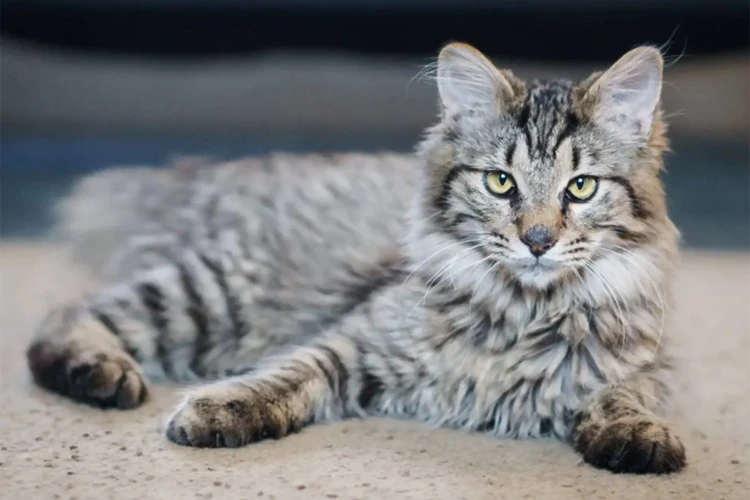
As you spend more time with your furry companion, you’ll start to pick up on their unique personalities and body language. Understanding the specific body language of American Bobtail cats can help you better communicate and bond with your feline friend. From playful to affectionate to aggressive behavior, it’s essential to read and interpret the subtle cues that your cat is giving you. Let’s explore some of the key body language signals that American Bobtails use to communicate their feelings and needs.
Playful Body Language
When American Bobtail cats are in a playful mood, they exhibit a unique set of body language cues. Such cues may be a result of their wild ancestry or just part of their natural behavior. Understanding these cues can help you better interact with your cat, so let’s take a look at some of the common indications of playful body language:
- Tail wagging: Just like dogs, American Bobtails will wag their tails when playful. If the tail is upright and wagging rapidly or gently, it is a sign that your cat is in a happy mood and wants to play.
- Chasing: If your cat is chasing after toys or even your fingers, they are likely in a playful mood. This is also an excellent opportunity to bond with your cat by using interactive toys and keeping them engaged.
- Kneading: When cats knead with their paws, it is a sign of comfort and happiness. So, if your American Bobtail kneads on your lap or on a blanket, it is a sign that they are in a playful mood.
- Pouncing: If your cat crouches down and gets into a position to pounce, it means they are ready to play. This is also another great opportunity to use interactive toys or even teach your cat to play fetch.
It’s crucial to keep in mind that every cat’s playful body language may vary based on their unique personalities and preferences. So, it’s essential to observe your cat’s behavior to understand their body language better and engage with them accordingly. Playing with your cat can help build a strong bond and provide essential exercise for their physical and mental wellbeing.
If your American Bobtail is not used to playing, you can start by introducing them to toys and gradually increasing the amount of playtime. It’s important to stimulate and engage their minds, so they don’t get bored and become destructive. You can also consider taking your cat for walks outside on a leash. This activity can be both fun and stimulating for your American Bobtail. You can learn more about leash training your cat in our train American Bobtail on a leash article.
The playful body language of American Bobtail cats involves tail wagging, chasing, kneading, and pouncing. Understanding these cues can help you better interact with your cat and have a more enjoyable time together. If your cat is not used to playing, you can start small and gradually increase the amount of playtime. Remember to have fun and bond with your American Bobtail. If you need more information about American Bobtails, read our American Bobtail Introduction article.
Affectionate Body Language
Affectionate body language in American Bobtail cats is incredibly endearing and heartwarming for pet owners. This type of body language is often seen when cats are relaxed and happy. Here are some common examples of affectionate body language in American Bobtail cats:
| Body Part | Description |
|---|---|
| Tail: | A relaxed tail that often sticks straight up in the air is a sign of an affectionate American Bobtail cat. Sometimes, the tip of the tail may even twitch when the cat is feeling particularly happy and content. |
| Purring: | When an American Bobtail cat purrs, it’s a clear sign of affection. Purring is often associated with happiness and relaxation, so if your cat is purring, it’s a good sign that they’re in a good mood and feeling content. |
| Head-butting: | When an American Bobtail cat rubs their head or forehead against you, it’s a sign of affection. This behavior is called bunting and is often used as a way to mark you as their own or to show that they feel comfortable and safe around you. |
| Kneading: | When an American Bobtail cat kneads with their paws, they’re showing affection and contentment. This behavior is often seen when a cat is happy and relaxed, and it’s a sign that they feel comfortable and safe in their environment. |
| Cuddling: | When an American Bobtail cat curls up next to you or in your lap, it’s a sign that they feel comfortable and safe around you. Cuddling is often associated with affection and love, and it’s a clear sign that your cat trusts you and feels relaxed in your presence. |
Understanding these affectionate behaviors can help you build a strong bond with your American Bobtail cat. If your cat is displaying affectionate body language, be sure to reciprocate by petting them and giving them the attention they crave. Additionally, if you notice your cat displaying any of these behaviors, it’s a good sign that they feel safe and comfortable in their environment, so continue to provide them with a loving and nurturing home.
Aggressive Body Language
When American Bobtail cats display aggressive body language, it’s important to take notice and understand what your cat is trying to communicate. The following are some behaviors to watch out for when your cat is feeling threatened, uncomfortable or aggressive.
- Bristled Fur: One of the common signs of aggression in a cat is bristled fur. When a cat feels threatened, it’s fur stands on end, making the cat appear larger and more intimidating.
- Dilated Pupils: Another common sign of aggression in American Bobtail cats is dilated pupils. This indicates that the cat is in a high state of arousal and is feeling threatened or uncomfortable.
- Growling and Hissing: Growling and hissing are aggressive vocalizations that American Bobtail cats make to warn potential threats to stay away. These sounds are often accompanied by an arched back and bristled fur.
- Whiskers Pulled Back: When a cat is feeling threatened or aggressive, it may pull its whiskers back against its face. This is a sign that the cat is ready to defend itself if needed.
- Direct Eye Contact: When a cat is feeling aggressive, it may stare down its target with direct eye contact. This is a warning to back away or else the cat may attack.
- Attacking: If the American Bobtail cat feels threatened or uncomfortable, it may resort to attacking as a way to defend itself. This can be dangerous for the handler or anyone else present.
It’s important to understand that an aggressive American Bobtail cat is not a happy cat, and it’s best to avoid interacting with them until they have calmed down. If the aggressive behavior persists, it may be best to consult a veterinarian or animal behaviorist for advice.
Understand Your Cat’s Body Language
When it comes to getting to know your American Bobtail cat, body language is an important factor to consider. It can be fascinating to observe how cats communicate through their body movements and behaviors. However, understanding your cat’s body language can be a bit of a challenge, especially for new cat owners. In this section, we will discuss some practical ways to better understand your American Bobtail’s body language so that you can build a stronger relationship with your furry friend. Let’s dive right in!
Consider the Context
When trying to understand the body language of American Bobtail cats, it’s crucial to consider the context in which their behavior is occurring. Cats communicate through various forms of body language, but their signals can often be misinterpreted if factors such as their age, environment, and health are not taken into account.
Here are some essential elements to consider when analyzing your cat’s body language:
- Age: A kitten may display different body language than an adult cat. Kittens tend to be more energetic and curious, and their body language may, therefore, be more playful.
- Environment: Cats adapt their body language depending on the environment they’re in. If they’re feeling stressed or uncomfortable in a particular setting, they may show signs of anxiety or aggression.
- Health: Cats that are ill may display unusual body language that is a reflection of their physical condition. For instance, if a cat is in pain, they may become withdrawn and stop grooming themselves.
- Familiarity: Your cat’s body language may differ depending on their familiarity with people, other animals, or objects. If your cat is well-acquainted with someone, they may display more relaxed body language.
By taking these contextual factors into account, you can begin to make sense of your cat’s postures, movements, and vocalizations. Keep in mind that American Bobtail cats have unique personalities and respond to situations in their way, so it’s essential to observe their body language over time and develop an understanding of their personality traits.
Observe Their Body Language Over Time
Observing your American Bobtail cat’s body language over time can be an effective way to understand their moods and behaviors. Here are some tips for doing so:
- Pay attention to your cat’s body language in different situations. Notice how they behave when they’re playing, relaxing, or interacting with other pets.
- Take note of any changes in their body language. If your cat suddenly starts exhibiting new behaviors, it may be a sign that something is wrong.
- Look for patterns in their behavior. If your cat displays certain body language cues before engaging in certain activities (such as jumping up onto a piece of furniture), you can start to anticipate their actions.
- Don’t rely solely on body language to understand your cat. Vocalizations, such as meowing or purring, can also provide important clues about their mood.
Remember to be patient when observing your cat’s body language. It may take some time to pick up on their subtle cues, and not all cats will exhibit the same behaviors. However, by paying close attention to their body language over time, you can gain a deeper understanding of your furry friend and create a stronger bond with them.
Pay Attention to Vocalizations
When it comes to understanding American Bobtail cats’ body language, paying attention to their vocalizations is crucial. Vocalizations are the various noises that cats make, and they can range from meows to hisses to purrs. Being able to interpret these sounds can help you better understand your cat’s mood and needs. Here are some vocalizations to take note of:
- Meowing: Meowing is one of the most common vocalizations that cats make. They use it to communicate with humans and other cats. A short, high-pitched meow can indicate a greeting, while a longer, drawn-out meow can indicate a demand for food or attention.
- Purring: Purring is a sign that your cat is content and relaxed. It can also indicate that they are seeking attention or affection. However, cats can also purr when they are in pain or stressed.
- Hissing: Hissing is a warning sign that your cat is feeling threatened or scared. If your cat is hissing, it’s important to give them space to calm down and feel safe.
- Growling: Growling is a sign that your cat is feeling aggressive or defensive. It’s important to be cautious and give them space when they are growling.
- Chirping: Chirping is a sound that cats make when they are excited or happy. It can be a sign that your cat is in a playful and friendly mood.
It’s important to pay attention to the context in which your cat is vocalizing. For example, if your cat is meowing excessively, it could be a sign that they are in distress or experiencing pain. If you notice any changes in your cat’s vocalizations, such as meowing more or less than usual, it’s essential to consult with a vet to rule out any underlying health issues. By paying attention to your cat’s vocalizations, you can better understand their needs and provide them with the care and attention they require.
Conclusion
As we conclude our exploration of American Bobtail cat body language, it’s important to remember that every cat is different and may express themselves differently. However, understanding the common body language cues of American Bobtails can help you better communicate with and care for your furry friend.
Observation is key – by paying attention to your cat’s body language over time and in different contexts, you can start to identify their unique signals of playfulness, affection, and aggression.
Vocalizations can also provide important insight into your cat’s emotional state. Purring can indicate relaxation and contentment, while meowing may signal a desire for attention or food.
Remember to respect your cat’s boundaries and not force them into uncomfortable situations. Allow them to approach you on their terms and create a safe environment where they can express their needs and desires through their body language.
By taking the time to understand and interpret your American Bobtail’s body language, you can strengthen your bond and provide them with the care and attention they deserve.
Frequently Asked Questions
What should I know about American Bobtail cats?
American Bobtail cats are known for their playful and affectionate nature. They have a unique bobbed tail and are known for their intelligence and adaptability. They also have a muscular, athletic build and are often compared to wild cats like lynxes and bobcats.
How do American Bobtail cats communicate?
American Bobtail cats communicate through body language, vocalizations, and scent marking. They use their tail, ears, and facial expressions to communicate their mood or intentions. They also use purring, meowing, and hissing to communicate vocally.
What does it mean when an American Bobtail cat’s tail is up?
When an American Bobtail cat’s tail is up, it means they are feeling confident and content. It’s a sign of happiness and relaxation.
What does it mean when an American Bobtail cat’s ears are flat?
When an American Bobtail cat’s ears are flat, it means they are feeling defensive or aggressive. It’s a sign that they are ready to defend themselves if necessary.
Why do American Bobtail cats purr?
American Bobtail cats purr for a variety of reasons. They may purr when they are happy, relaxed, or content. They may also purr when they are feeling anxious or in pain, as a way to self-soothe.
What does it mean when an American Bobtail cat meows?
When an American Bobtail cat meows, it can mean a variety of things. They may be asking for food or attention, or they may be expressing discomfort or pain. It’s important to pay attention to the tone and frequency of their meows to understand what they are trying to communicate.
What does it mean when an American Bobtail cat arches their back?
When an American Bobtail cat arches their back, it is a sign that they are feeling threatened or scared. They may be trying to make themselves look bigger to deter a potential threat.
How can I tell if my American Bobtail cat is playing or being aggressive?
When an American Bobtail cat is playing, they will be energetic and playful, but their body language will be loose and relaxed. When they are being aggressive, their body language will be tense and their movements will be quick and deliberate. It’s important to pay attention to the context and the cat’s overall behavior to understand their intentions.
How can I tell if my American Bobtail cat is affectionate?
When an American Bobtail cat is affectionate, they will often seek out physical contact, such as snuggling or rubbing against their owner. They may also show other signs of relaxation, such as blinking slowly or purring.
What should I do if I don’t understand my American Bobtail cat’s body language?
If you are unsure what your American Bobtail cat is trying to communicate, it’s important to observe their behavior over time and to pay attention to their vocalizations. You can also consult with a veterinarian or animal behaviorist for additional guidance.

